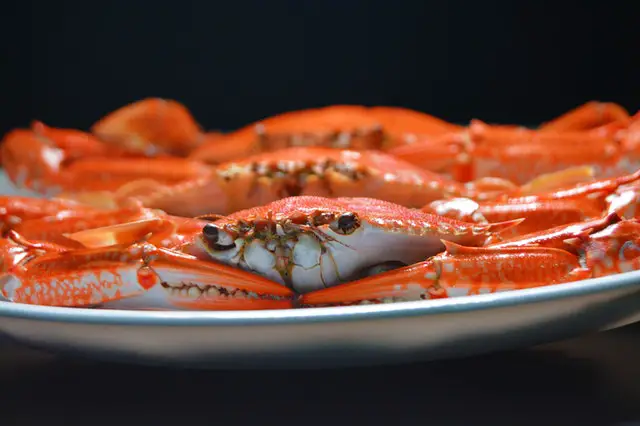Dungeness crabs are Cancer Magister.
Relax, i know what you’re thinking, but that’s exactly the opposite of what i’m saying. Cancer magister is the scientific name assigned to the Dungeness crab by the Integrated Taxonomic Information System (ITIS).
I know, we better stop here before things get too scientific and the purpose of the article slowly drifts away like a moving iceberg.
So without wasting any time, let me introduce the subject of discussion; how long to boil Dungeness crabs — one of the most popular source of joy for seafood gourmets around the Pacific Coasts, and us too that are miles away from the picture.
In this article, you’ll learn exactly the time it takes for a Dungeness crab to reach optimal doneness in a pot of hot water, with of course a plethora of supporting paragraphs that explain exactly the steps to follow in order to achieve this. Sounds good? Let’s get started then.
How long to boil Dungeness crab
| s/n | Dungeness Crab | Boiling time | Frozen |
| 1 | Average Dungeness crab (whole), about 2 pounds. | 15 minutes | 20 minutes |
| 2 | Small Dungeness crab (whole), less than 2 pounds. | 12 minutes | 18 minutes |
| 3 | Large Dungeness crab (whole), about 3 ½ to 4 ½ pounds | 22 minutes | 33 minutes |
| 4 | Dungeness Crab halves | 11 minutes | 16.5 minutes |
| 5 | Dungeness Crab cleaned and segmented | 11 minutes | 16.5 minutes |
The above table shows you how long to boil a Dungeness crab to doneness, what it doesn’t show you however, is how to properly boil a Dungeness crab for perfect doneness. For that, continue reading until the very last word.
How to cook Dungeness crab
Dungeness crab is the salient food of the West Coast. Popular as it is, not many people know how to prepare it like they know how to snatch up it’s best deals, however. But the steps for its preparation are super easy for anyone to follow and triumph. You’ll be learning them in a moment.
The crab
The first step to preparing a Dungeness crab is killing it. There are continuous debates amongst scientists regarding whether or not crabs are capable of feeling pain such as the one derived from submerging them in boiling water. Some say pain exists and is remembered, others fiercely debate its existence.
But we’re not here to take sides or prove any claims, we’ve made up our minds to eat the crabs anyway. What we must consider now, regardless of the results of any research, is killing the crab in the most humane way possible. The animal is a living creature like you after all.
I have done a proper research on this, and the proper way that I have found is half backing.
The process is simple. Just turn the crab on its back, place the sharp end (blade) of a knife or cleaver directly on the mid-section of the crab (against the abdomen), and use a mallet to quickly drive the blade through the crab in one hit.
This method of killing is very quick with the least pain suffered by the animal. It also has the added benefit of making the crab tastier, safer, and less odorous according to a Dungeness crab cooking guide published by the Humboldt BayKeeper.
I’ll speculate that half backing a crab and then cleaning it by scooping out the guts and gills will make the meat much safer than cooking the crab whole because it reduces the risks of contaminating the meat by the flavor and toxins of the guts.
If you need to grab a live crab for killing when you’re shit scared of its claws, use a tong to clamp its rear. You can also use your hands exactly the way you’ll use the tongs; meaning that you pack together all your fingers with the exception of the thumb, and then form a U shaped funnel just like a tong. Use it to grab the crab from behind (do not run your fingers past the center of the underside). That will keep the claws facing front and away from pinching your fingers.
Cleaning the Dungeness crab
After half backing and therefore killing the crab, the next thing on the list is clean up the crab before cooking. Do not clean a halved crab after you’ve cooked it.
Yes, it’s easier, the preparation is faster, and it also has the added advantage of protecting the body meat from residues in the cooking water. But it still cannot match the convenience and speed in cooking, the elimination of visceral taste and the facilitation of salt penetration into the body of the meat (flavor) that cleaning a crab prior to cooking offers.
So back to business. At this stage, the crab is split in roughly equal halves that are still attached to the carapace (or shell). You want to pull them away from the carapace and discard the shell and its gut contents or repurpose it for whatever you like. Just make sure you’re not eating the crab butter, mustard, liver or hepatopancrease present in the shells. These are known to frequently retain harmful toxins which can cause food poisoning.
Next, remove the gills from each half of the crab which are located near the crab legs. Then remove the mouth parts and tail flap, and then with the crab on your hand, flick your wrist to remove some of the visceral mass (crab butter) present on the crab meat. Now rinse both half thoroughly under cold water to eliminate any remaining residue and the halves are ready for cooking.
Boiling the crab
Fresh Dungeness crab is full of flavor from salt in the oceans. In order to preserve all of this flavor while cooking the crabs, you want to replicate the exact concentration of an ocean’s salt content in your boiling water.
The general rule of thumb is to use 3 to 5 ounces of salt per gallon of fresh water when coking crab sections according to a publication titled “Catching, Cleaning, and Cooking Bay Crabs” issued by the Oregon State University.
The guide also stated the ratio when using bay water instead of fresh water and also when using whole crabs instead of section. The ratios are 2 ounces per gallon of bay water and 6 to 8 ounces per gallon of fresh water respectively.
An alternative to preserving flavor while ditching the salt is to steam the meat. This normally take around 15 to 20 minutes and the resulting meat is equally as tender and flavorful with less nutrients leached as meat boiled in a brine.
After salting, season as desired or leave the brine water as it is, and then bring to a boil. Dip the crab halves into the boiling water and wait for the water to return to a boil; the crabs normally reduce the temperature of the water to below boiling for a moment. Next, place a lid on the pot and cook the crabs according to the table provided above.
After expiration of the time, remove the crabs from the boiling water using a tong and immediately transfer into a bowl containing iced water.
This step helps with three things. First is to stop the meat from cooking any further which will cause it to overcook, second is to enable the meat effortlessly release from its shells, and third is to prevent drying and shrinkage of the meat.
You want to cool meat for about 10 minutes or until the temperature is back to room temperature.
De-shelling
After boiling and cooling, it’s time to remove de-shell. To do that,
Pick one of the halves and separate each one of the legs until you have no body remaining. This means that you should break off the legs with the adjacent body segment attached to them.
This should leave you with some body parts on each leg that you break. After you’re done with the first half, proceed to do the same thing with the second half. Don’t worry if some of the meat aren’t coming off with the legs, the meats are still going to be detached from the shells anyway.
When you’re done, it’s time to crack and release some crab meat.
Let’s start off with the adjacent body meat from above. Take up each leg and strike it gently against the inner sides of a bowl. This should release them meat into the bowl. For stubborn residues, use a chopstick or a shrimp fork, or other pointy objects around the kitchen to pull out the meat from the shell.
Next you want to use a crab cracker to crack each section of the legs and break off the shell pieces to reveal the meat. If you’re using a mallet, cleaver, rolling pin, or a small hammer, you want to be especially careful so you don’t end up compromising the integrity of the meat, especially if a recipe calls for it.
For stubborn residue of meat, use a chopstick or the pointy tip of a crab leg to pick them out. And that’s it. You’ve got yourself some delicious crab meat ready for serving.
Serving
Use crab meat the way you like it. The options out there are endless, here are some of them.
- Make a crab salad with veggies of all colors
- Make an imperial crab
- Make crab Louis
- Make crab cakes
- Use crab meat in pasta and risottos
- Use crab meat as a canapé topping.
Related Questions
How long to boil Dungeness crab legs
Boil Dungeness crab legs for 11 minutes in a boiling brine solution. The cooked meat should have a naturally flaky texture, be delicate, and exude a naturally sweet aroma.
How long to boil frozen Dungeness crab
Boil frozen Dungeness crab for one and a half time the normal boiling time. This mean to boil for 20 minutes for the average Dungeness crab and 33 minutes for large Dungeness crabs (whole). Crabs sectioned and frozen should be allowed to cook for upto 16.5 minutes.
How long to boil frozen precooked Dungeness crab
Boil frozen precooked Dungeness crab for 6 to 8 minutes to heat up well.


